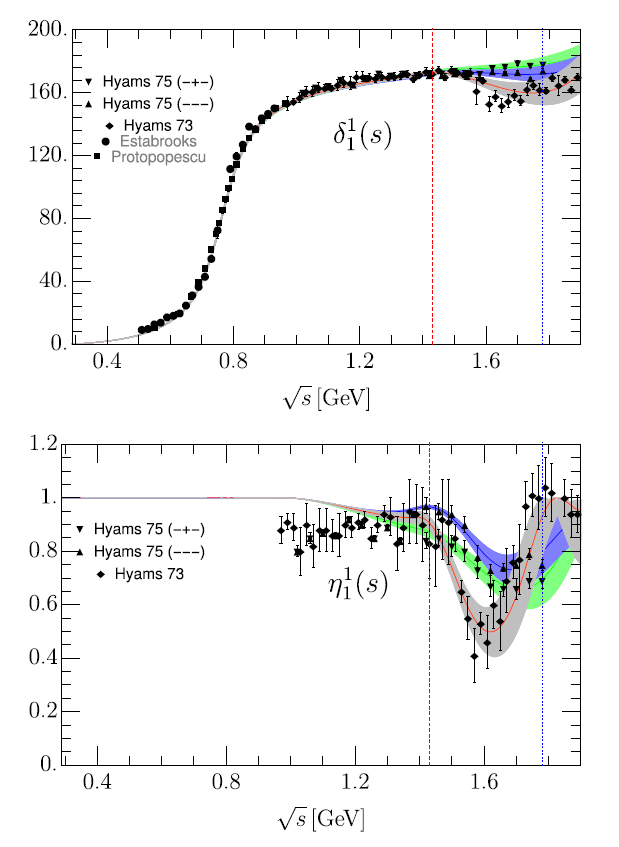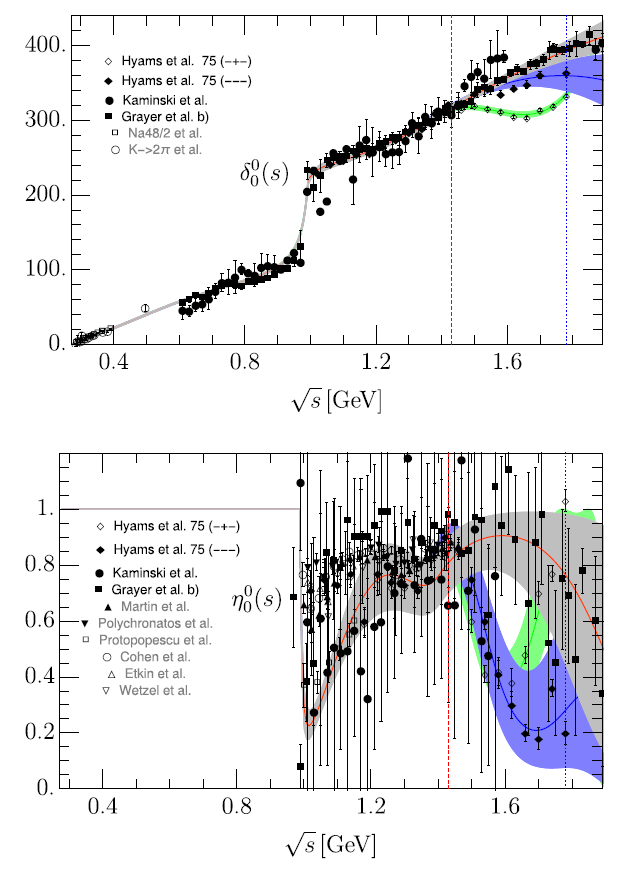Task 1.1 - Development and application of EFTs
Coordinator: Christoph Hanhart
Contirbutors: Alessandro Lovato, David Rodríguez Entem , Laura Tolos , Assumpta Parreño, Volodymyr Magas , Monica Bertani, Simone Pacetti, Alessio Mangoni, Àngels Ramos, Joan Soto, Antonio Vairo, Nora Brambilla, Rafel Escribano
General description:
Chiral perturbation theory, Heavy Quark, Effective Theory or Quarkonium, Non Relativistic EFTs and the newly developed Born Oppenheimer EFT are exploited. If appropriate tailor made unitarization methods and dispersive techniques are employed in addition, to set up a robust framework to study QCD in the non-perturbative regime. These studies provide access to the spectrum, and in general the phenomenology of hadrons both in the free space and in extreme environments. In addition, the possible role of kinematic singularities, the so-called triangle singularities, in generating experimental signals, is investigated.
Progress [1-18 months]:
There has been a significant progress in the project. Results have been presented in a good number of international conferences and workshops, celebrated in person before the Covid pandemic, or remotely in the last months.
List of achievements:
1. EFTs for regular Quarkonia: Development of a potential nonrelavistic QCD description of electromagnetic and hadronic regular quarkonium production at high energy accelerators [Br20a].
2.EFTs for exotic hadrons, which can be classified attending to the employed degrees of freedom: quarks or hadrons:
2.1 Formulation of an EFT, in terms of quark degrees of freedom to describe hadrons with two heavy quarks, without any assumption on the typical distance between the heavy quarks with respect to the typical hadronic scale, and avoiding the compact diquark approximation. The formalism has been applied to obtain the spectrum of double charm and bottom baryons, using lattice QCD data for the static potentials [So20a]. In addition, the spin structure of heavy-quark hybrids has been discussed within the non-relativistic Born-Oppenheimer-EFT approach up to next-to-leading order in the heavy-quark mass expansion [Br20b].
2.2 Taking hadrons as effective degrees of freedom, we have studied several exotic hadrons employing unitarised ChPT (or some extensions).
a) In the baryon sector, molecular states amongst the excited nucleon and hyperon resonances [Ra20, Ik20a], odd-parity resonances with open charm and/or bottom [Ni20, Li20a], or strange SU(3) partners of the LHCb pentaquarks [Xi19] have been considered. Also in this context, an EFT constructed analogous to the one now routinely used for few nucleon systems is employed to analyse the pentaquark data by LHCb [Du20].
b)In the meson sector, we developed the complete next-to-leading order potential for BB* and B*B* scattering, which is used to provide deeper insights into the nature of the Zb (10610) and Zb (10650) [Kr20]. The effect of triangle singularities on experimental signatures is employed to propose a high accuracy determination of the mass of the X(3872) [Sa20].
Finally, within our research on exotic states in terms of hadron degrees of freedom, we refer to the findings in [Ma20a], where a criterion to quantify the two hadron component of virtual states is provided.
3.Phenomenological studies of hadronic transitions:
3.1 A dispersive model-independent analysis of πK and ππ→KK partial-wave in the low energy region below 1.6 GeV is performed in [Pe20a], using coupled forward, fixed-t and hyperbolic dispersion relations. The results consist of precise and ready-to-use partial wave parameterizations for further final-state interaction studies, as well as a model independent determination of the lightest strange meson. We have also provided a simple and easy-to-use description of ππ S and P partial-wave data up to 2 GeV, which reproduces as well accurately the hadron resonance poles in these processes. This description is consistent with Forward and crossing-symmetric (Roy) dispersion relations [Pe20b]. Finally, we mention the development in [De20] of a new parametrization for πK S-wave scattering and the corresponding form factor valid up to 2.3 GeV.

Global fit of the ππ P partial wave data, up to 2 GeV.

Global fit of the ππ S partial wave data, up to 2 GeV.
3.2 The structures observed recently at LHCb in the J/ψ-J/ψ channel are analysed in a coupled-channel framework including the relevant double-vector channels. An additional state near J/ψ-J/ψ threshold is predicted [Do20].
4. Effective field theories at non zero temperature
4.1. The effect that a hot pion bath may have on the properties of the X(3872) is studied in the molecular model. It is found that it develops a width of some tens MeV which may have implication for X production in heavy ion collisions [Cl19].
4.2 First calculations of the vacuum and thermal properties of pseudoscalar and vector charm mesons within a self-consistent many-body approach, employing a chiral effective field theory that incorporates heavy-quark spin-symmetry (HQSS) [Mo20a]. The open-charm Euclidean correlators have been also computed for the first time in [Mo20b] using the thermal spectral functions extracted from a finite-temperature self-consistent unitarized approach based on a chiral effective field theory that implements (HQSS) The results compare well with those from lattice QCD.
5. Development of new methods to handle problems in hadron physics
5.1 Development of a symbolic manipulation program to calculate matching coefficients in non-relativistic EFTs [Br20c]
5.2 We use quark-model potentials as input in quantum Monte-Carlo (MC) methods to compute the spectrum of tetra and pentaquark systems containing heavy quarks. We successfully benchmarked quantum MC predictions for cc and bb states against numerically-exact Gaussian-basis results. We expect this analysis to complement ongoing efforts to reveal the spectrum of such states using simpler quark model approaches on one hand and realistic Faddeev equation analyses on the other [Go20].
References:
-
[Br20a] Nora Brambilla, Hee Sok Chung, Daniel Müller, Antonio Vairo, JHEP 04 (2020) 095; Nora Brambilla, Hee Sok Chung, Antonio Vairo, e-Print: 2007.07613.
-
[So20a] Joan Soto, Jaume Tarrús Castellà, Phys.Rev.D 102 (2020) 014012; Phys.Rev.D 102 (2020) 014013.
-
[Br20b] Nora Brambilla, Wai Kin Lai, Jorge Segovia, Jaume Tarrús Castellà, Phys.Rev.D 101 (2020) 054040.
-
[Ra20] A. Ramos, A. Feijoo, Q. Llorens and G. Montaña, Few-Body Syst 61, 34 (2020).
-
[Ik20a] N. Ikeno, G. Toledo and E. Oset, Phys. Rev. D 101 (2020) no.9, 094016
-
[Ni20] J.Nieves, R.Pavao and L.Tolos, Eur. Phys. J. C 80 (2020) 22; J. Nieves and R. Pavao, Phys. Rev D101 (2020) 034014; J. Nieves,HADRON 2019, 19-26 (World Scientific)doi:10.1142/9789811219313_0003; L. Tolos, J. Nieves and R. Pavao, HADRON 2019, 198-203 (World Scientific) doi:10.1142/9789811219313_0031
-
[Li20a] W.~H.~Liang and E.~Oset, Phys. Rev. D 101 (2020) 054033; Q. X. Yu, J. M. Dias, W. H. Liang and E. Oset, Eur. Phys. J. C 79 (2019) 1025;
-
[Xi19] C.-W. Xiao, J. Nieves and E. Oset, Phys. Lett. B799 (2019) 135051.
-
[Du20] M. L. Du, V. Baru, F.-K. Guo, C. Hanhart, U.-G. Mei§ner, J.A. Oller and Q. Wang, Phys. Rev. Lett. 124 (2020) 072001
-
[Kr20] Simon Krug, Vadim Baru, Alexey Nefediev, Arseniy Filin, and Christoph Hanhart, in preparation
-
[Sa20] S. Sakai, E. Oset and F. K. Guo, Phys. Rev. D101 (2020) 054030; R. Molina and E. Oset, Eur. Phys. J. C 80 (2020) 451.
-
[Ma20a] I. Matuschek, V. Baru, F.-K. Guo and C. Hanhart, arXiv:2007.05329 [hep-ph].
-
[Pe20a] J.R.Peláez and A.~Rodas, Phys. Rev. Lett. 124 (2020) 172001 [arXiv:2001.08153 [hep-ph]]
-
[Pe20b] J. R. Peláez, A. Rodas and J. Ruiz De Elvira, Eur. Phys. J. C 79 (2019) 1008 [arXiv:1907.13162 [hep-ph]].
-
[De20] Leon von Detten, Frederic Noel and Christoph Hanhart, in preparation
-
[Do20] X.K. Dong, V. Baru, F.-K. Guo, C. Hanhart and A. Nefediev, arXiv:2009.07795 [hep-ph]
-
[Cl19] Martin Cleven, Volodymyr K. Magas, Angels Ramos, Phys. Lett. B 799 (2019) 135050
-
[Mo20a] G.Montaña, A. Ramos, L. Tolos and J.M. Torres-Rincon, Phys. Lett. B 806 (2020), 135464; arXiv:2007.12601 [hep-ph]
-
[Mo20b] G.Montaña, O.Kaczmarek, L.Tolos and A.Ramos, arXiv:2007.15690 [hep-ph]
-
[Br20c] Nora Brambilla, Hee Sok Chung, Vladyslav Shtabovenko, Antonio Vairo, e-Print: 2006.15451
-
[Go20] Carmen Gordillo, Alessandro Lovato, Jorge Segovia, and Feliciano de Soto, in preparation
